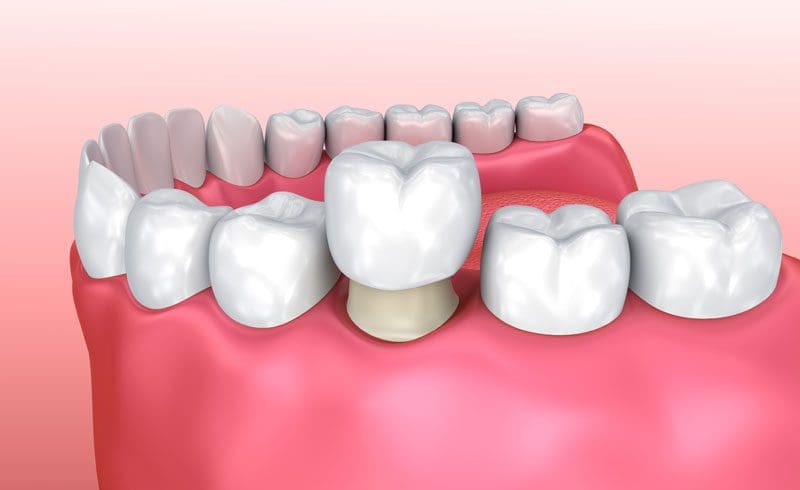Whenever a missing part is replaced, it is called prosthesis, and when the prosthesis cannot be removed it is a fixed prosthesis. Crowns, bridges and implants are the best examples of this.
A crown is very versatile, can be placed either over an existing natural tooth or on an implant to replace the natural crown of a tooth.
A bridge on the other hand can be two or more crowns on an implant. Or a unit of three or more teeth outer most crown is placed on natural teeth this is called the abutment and suspended with its support is the pontic. The entire unit is called a bridge.
Situations that make crowns an ideal choice
- Very often the tooth gets chipped or fractured. Particularly the front tooth. This should ideally be covered with crown.
- When there is deep caries, after excavation if the tooth loss is a lot, a crown is considered a better option to a large restoration or a filling. It not only strengthens the tooth it also protects it.
- After a root canal, the tooth needs protection, and support again a crown is a very good option.
- If an existing restoration has fractured re-restoring it would mean loss of more tooth surface area, in which case placing a crown over it will strengthen the tooth.
Situations where a bridge is placed
- When one or more tooth is missing.
- When a patient wants a permanent solution to the existing removable partial denture.
The benefits of having crown and bridge
- Since the crown and bridge covers the tooth completely it is the best way to protect the tooth from pressure and sensitivity. It also prevents further degeneration of the tooth.
- A crown or bridge resembles the natural bite pattern and structure. This means there is less support tissue damage. There is also a balance in the bite pattern. This balance allows maintaining the health of the TMJ (temperomandibular joint) or the joint that holds the lower jaw to the upper.
- A crown or bridge prevents the neighbouring teeth from drifting and the opposing tooth from over erupting. This again helps to maintain the overall health of the oral cavity.
- Better aesthetics is maintained because both teeth alignment and facial contours are maintained.
- Makes eating more easy
- Long lasting 15-20yrs unlike the removable denture
- Easy maintenance. – Normal oral hygiene procedure.
The materials used for crown and bridge
Crowns and bridges are made from varied materials, gold, Porcelain, alloys, acrylic etc. The decision on which one to use is usually agreed upon by the dentist, the dental lab technician and the patient after considering the requirement and the cost.
Procedure for crown placement
- Preliminary analysis of the health of the bone and support teeth is done.
- Oral prophylaxis.
- The tooth will be prepared by eliminating the decayed debris and the healthy tooth is trimmed such that the crown or bridge can be seated on it.
- After that, an impression of the tooth is taken and sent to the lab where the crown or bridge is fabricated.
- Until then for the protection of the prepared tooth a temporary crown is placed.
- Once the crown or bridge is fabricated the temporary crown is removed and the permanent crown or bridge is placed. This lasts for 15-20yrs.
Bridge designs
The designs of the bridge can be of 4 types:
Traditional
There is a false tooth suspended between two abutments or support teeth. There missing tooth has the support of the natural tooth on either side.
Cantilever
The missing tooth here is held by only one natural tooth.
Maryland
It has two abutments supporting the missing tooth. The difference here one tooth is a full crown while the other is a framework that is bonded to the back of the abutment. This frame work could be metal or ceramic.
Implant supported
Here an implant is placed for every missing tooth and this implant supports the crown. In case it is not possible to have implants for each tooth then bridge may have a pontic suspended on two crowns that implant supported.
Materials that are used in crowns and bridges
The following are the materials commonly used for crowns and bridges, and their advantages and disadvantages.
Porcelain veneer, zircon
Advantage: Strong, natural looking low cost.
Disadvantage: It burdens the adjacent tooth. Porcelain tends to chip.
Lithium disilicate
Advantage: It blends with natural tones and does not require veneer Disadvantage: Its strength is very poor.
Ceramic
Advantage: Blends well aesthetically, very well for people who are intolerant to metals. Can be used on both front and back tooth. Is a good temperature buffer.
Disadvantage: Susceptible to pressure, and has a tendency to chip. Requires more tooth preparation.
Gold
Advantage: Strong, biocompatible that is it does not damage the adjacent tissues.
Disadvantage: Very expensive, and not aesthetic
Base metal alloys
Advantage: Strong alloys blended with gold. Does not fracture. It does not load the support tissues or damage the adjacent tissues. Minimum tooth preparation required.
Disadvantage: Expensive and not aesthetic.
Stainless steel
Advantage: This is used for a child who’s deciduous or a milk tooth needs to preserve until their age of natural shedding. These are prefabricated, and cost effective.
Disadvantage: Not aesthetic.
Once the procedure of crown or bridge is complete and it is placed in the oral cavity. It lasts for almost 15-20yrs. The individual regains functional efficiency and aesthetic restoration. All the same, certain fundamental care has to be maintained.
Normal oral hygiene procedure needs be maintained, but it has to be maintained meticulously. If the bridge or crown dislodges or fractures call the dentist immediately.

